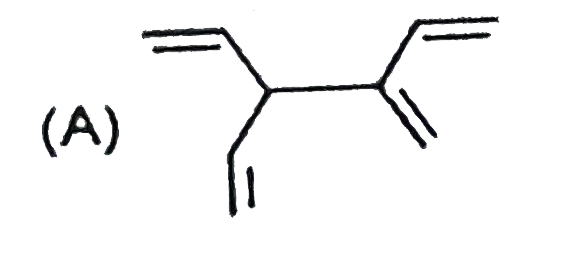Diethenyl pentadiene is :




To determine the structure of diethenyl pentadiene, we will follow these steps:
Step 1: Understand the IUPAC Name
The name "diethenyl pentadiene" can be broken down into parts:
- "pentadiene" indicates that the compound has five carbon atoms (pent-) and two double bonds (diene).
- "diethenyl" suggests that there are two ethene (C=C) groups acting as substituents.
Step 2: Draw the Carbon Backbone
Since "pentadiene" indicates five carbon atoms in the main chain, we will start by drawing a straight chain of five carbon atoms:
C1−C2−C3−C4−C5
Step 3: Add the Double Bonds
As "diene" indicates the presence of two double bonds, we need to place two double bonds in the carbon chain. The most common placement for double bonds in pentadiene is between the first and second carbon, and between the third and fourth carbon:
C1=C2−C3=C4−C5
Step 4: Add Ethene Substituents
The term "diethenyl" indicates that there are two ethene groups as substituents. An ethene group can be represented as:
C∣C=C
We will attach two ethene groups to the main chain. The common positions for substituents in organic compounds are usually at the ends or at the first carbon. For this case, we can attach one ethene group to the first carbon and another to the second carbon:
C|C=C−C=C−C|C
This structure shows that the first and second carbons each have an ethene group attached.
Step 5: Final Structure
The final structure of diethenyl pentadiene can be represented as:
C|C=C−C=C−C|C
This structure satisfies the conditions of having five carbon atoms in the main chain, two double bonds, and two ethene substituents.
The name "diethenyl pentadiene" can be broken down into parts:
- "pentadiene" indicates that the compound has five carbon atoms (pent-) and two double bonds (diene).
- "diethenyl" suggests that there are two ethene (C=C) groups acting as substituents.
Since "pentadiene" indicates five carbon atoms in the main chain, we will start by drawing a straight chain of five carbon atoms:
C1−C2−C3−C4−C5
As "diene" indicates the presence of two double bonds, we need to place two double bonds in the carbon chain. The most common placement for double bonds in pentadiene is between the first and second carbon, and between the third and fourth carbon:
C1=C2−C3=C4−C5
The term "diethenyl" indicates that there are two ethene groups as substituents. An ethene group can be represented as:
C∣C=C
We will attach two ethene groups to the main chain. The common positions for substituents in organic compounds are usually at the ends or at the first carbon. For this case, we can attach one ethene group to the first carbon and another to the second carbon:
C|C=C−C=C−C|C
This structure shows that the first and second carbons each have an ethene group attached.
The final structure of diethenyl pentadiene can be represented as:
C|C=C−C=C−C|C
This structure satisfies the conditions of having five carbon atoms in the main chain, two double bonds, and two ethene substituents.
Topper's Solved these Questions
Similar Questions
1,3-pentadiene and 1,4-pentadiene are compared with respect to their intrinsic stability and reaction with HI. The correct statement is :
View SolutionThe enthalpy of hydrogenation for 1-pentene is +126 kJ/mol. The enthalpy of hydrogenation for 1, 3-pentadiene is +230 kJ/mole. Hence estimate the resonance energy of 1, 3-pentadiene.
View SolutionAddition of one equivalent of bromine to 1, 3-pentadiene at temperature below 0∘C produces :
View Solution1,3- Pentadiene and 1,-4 - pentadiene are compared with respect to their intrinsic stability and reaction with HI . The correct statement is
View SolutionHydrogenation of unsaturated hydrocarbons is an exothermic reaction. Due to hyperconjugation and resonance the stability of unsaturated hydrocarbons increases and the increase in stability is more due to resonance. Compound with same number of π−bonds and more stability has lower heat of hydrogenation.
Heat of formation is defined as the energy evolved when a molecule is formed from its atoms. For isomers the more stable compounds has higher heat of formation.
The correct heat of hydrogenation order is :
(p) 1,3-Pentadiene
(q) 1,3-Butadiene
(r) 2,3-Dimethyl-1,3-butadiene
(s) Propadiene
View SolutionCorrect the following names :
3-ethyl-2-chloro-1, 4-pentadiene.
View Solution1,4-Pentadiene reacts with excess of HCl in the presence of benzoyl peroxide to give compound X, which upon reaction with excess of Mg in dry ether forms Y. Compound Y on treatment with ethyl acelate followed by treatment with dilute acid yields Z. Identify the structure of componds. X,Y and Z.
View SolutionThe concept of resonance explains various properties of compounds.The molecules with conjugated system of π bonds, are stabilized by resonace and have low heat of hydrogenation.Hyperconjugative stabilization also decreases heat f hydrogenation.In aromic rings a functional group with a lone pair of electron exerts +m effect. Some functional groups like -NO, -NC, -CH=CH2 can function both as electron releasing (+m,+R) or electron withdrawing (-m,-R) groups.More extended conjugation provides more stabilization.
The correct heat of hydrogenation order is
(p)1,3-Pentadiene , (q)1,3-Butadiene , (r)2,3-Dimethyl-1,3-butadiene , (s)Propadiene
View SolutionThe concept of resonance explains various properties of compounds.The molecules with conjugated system of π bonds, are stabilized by resonace and have low heat of hydrogenation.Hyperconjugative stabilization also decreases heat f hydrogenation.In aromic rings a functional group with a lone pair of electron exerts +m effect. Some functional groups like -NO, -NC, -CH=CH2 can function both as electron releasing (+m,+R) or electron withdrawing (-m,-R) groups.More extended conjugation provides more stabilization.
The correct heat of hydrogenation order is
(p)1,3-Pentadiene , (q)1,3-Butadiene , (r)2,3-Dimethyl-1,3-butadiene , (s)Propadiene
View Solution
